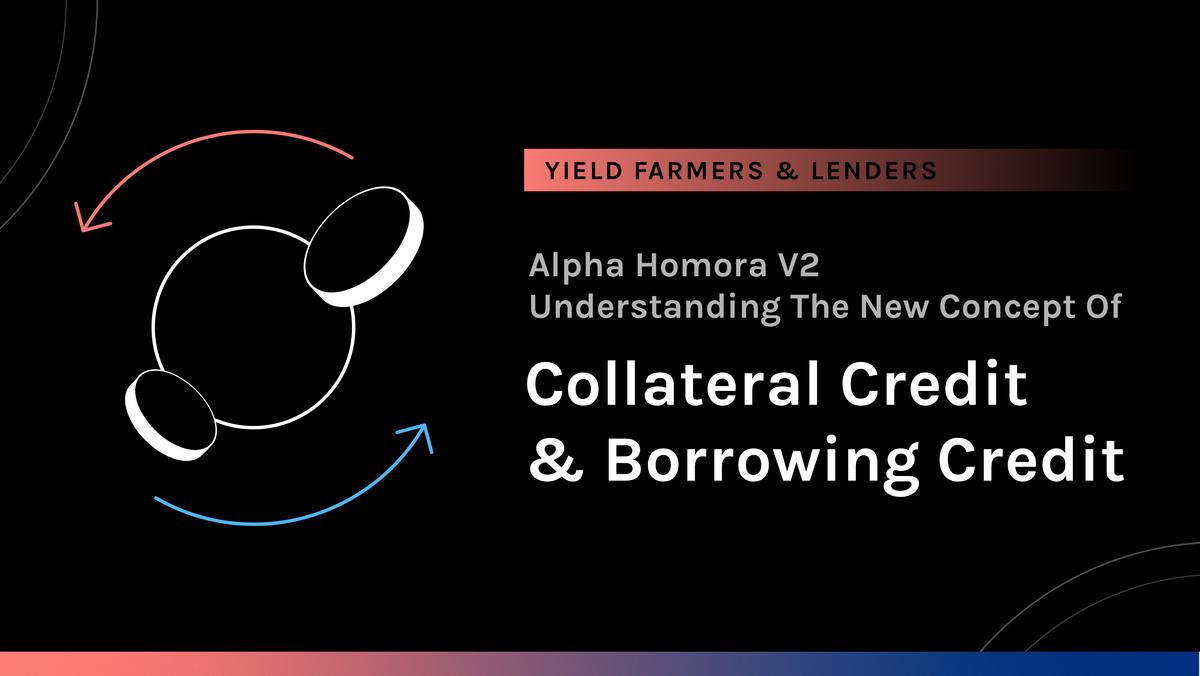Alpha Homora V2 - Understanding The New Concept Of Collateral Credit & Borrowing Credit

As a part of Alpha Homora V2 relaunch, lenders will be able to lend many assets in addition to ETH and stablecoin. This functionality translates to more assets borrowers can borrow to leveraged yield farm. In order to optimize for both capital efficiency and security, Alpha Homora v2 introduces a new concept in DeFi - collateral credit and borrowing credit.
Collateral Credit & Borrowing Credit
Alpha Homora v2 uses the concept of collateral credit and borrowing credit to determine how much leverage a user can get given which asset(s) is supplied and which asset(s) is borrowed to yield farm. With this mechanism, Alpha Homora v2 can set leverage and buffer parameters according to the volatility of each asset to ensure maximum capital efficiency and security of the protocol.
Note that collateral credits and borrowing credits are different from collateral ratio or loan-to-value ratio implemented in other protocols.
What is a collateral credit?
A collateral credit determines how much credit is gained from collateralizing an asset. The more volatile an asset, the lower the collateral credit. For instance, $1 of ETH gets 0.8 credit while $1 of SUSHI gets 0.67.
What is a borrowing credit?
A borrowing credit determines how much credit is consumed from borrowing an asset. The more volatile an asset, the higher the borrowing credit. For instance, borrowing $1 of ETH would consume 1.3 credit while borrowing $1 of SUSHI would consume 1.5.
Example Scenario
So how would this work in reality?
Bob supplies ETH to borrow DAI in Uniswap's ETH-DAI pool
Given the analysis that we have done, $1 of ETH will get 0.80 collateral credit. $1 of DAI will get 0.95 collateral credit. To borrow $1 of DAI, DAI would consume 1.05 credit, which represents DAI’s borrowing credit.
If Bob supplies $100 of ETH in the first step of Uniswap’s ETH-DAI pool
→ he would get ~80 credit.
→ Bob wants to borrow $600 worth of DAI, which will consume 630 credit (600*1.05).
→ At the same time, this $600 worth of DAI also adds 570 collateral credit (600*0.95) because...
→ ...the borrowed DAI contributes to the LP token of Bob's position, and the actual collateral on Alpha Homora V2 platform is the LP token itself.
→ Thus, Bob can achieve 7.0x leverage while staying solvent on the protocol level (total collateral credit of 650 vs. total borrow credit of 630).
Since collateral credit and borrow credit are distinct for each asset, the above scenario will change if Bob were to supply ETH and borrow a different token that is not DAI.
To see the previous blog on how we get fair pricing of LP token, see here.
Closing Thoughts
The concept of collateral credit and borrowing credit that we came up with will allow Alpha Homora V2 to achieve both capital efficiency and security as a lending and leveraged yield farming protocol.
This concept is in addition to the 3-slope interest rate model that we shared before, which also plays an important role in maximizing capital efficiency and asset utilization by baking in both variable and fixed interest rate mechanics.
As a result of these two concepts, Alpha Homora V2 will maximize capital efficiency and bring unique value proposition to both lenders and borrowers/leveraged yield farmers.
About Alpha Finance Lab
Alpha Finance Lab is a DeFi Lab and on a mission to build an ecosystem of DeFi products (the Alpha ecosystem), consisting of innovative building blocks that capture unaddressed demand in key pillars of the financial system. These building blocks will interoperate, creating the Alpha ecosystem that will be an innovative and more capital efficient way to banking in DeFi.
Alpha Homora is Alpha Finance Lab’s first product and DeFi’s first leveraged yield farming product that captures the market gap in lending, one of the key pillars of the financial system.
Join our Telegram/Discord/Blockfolio for the latest updates, follow us on Twitter, or read more about us on our Blog and Document!
